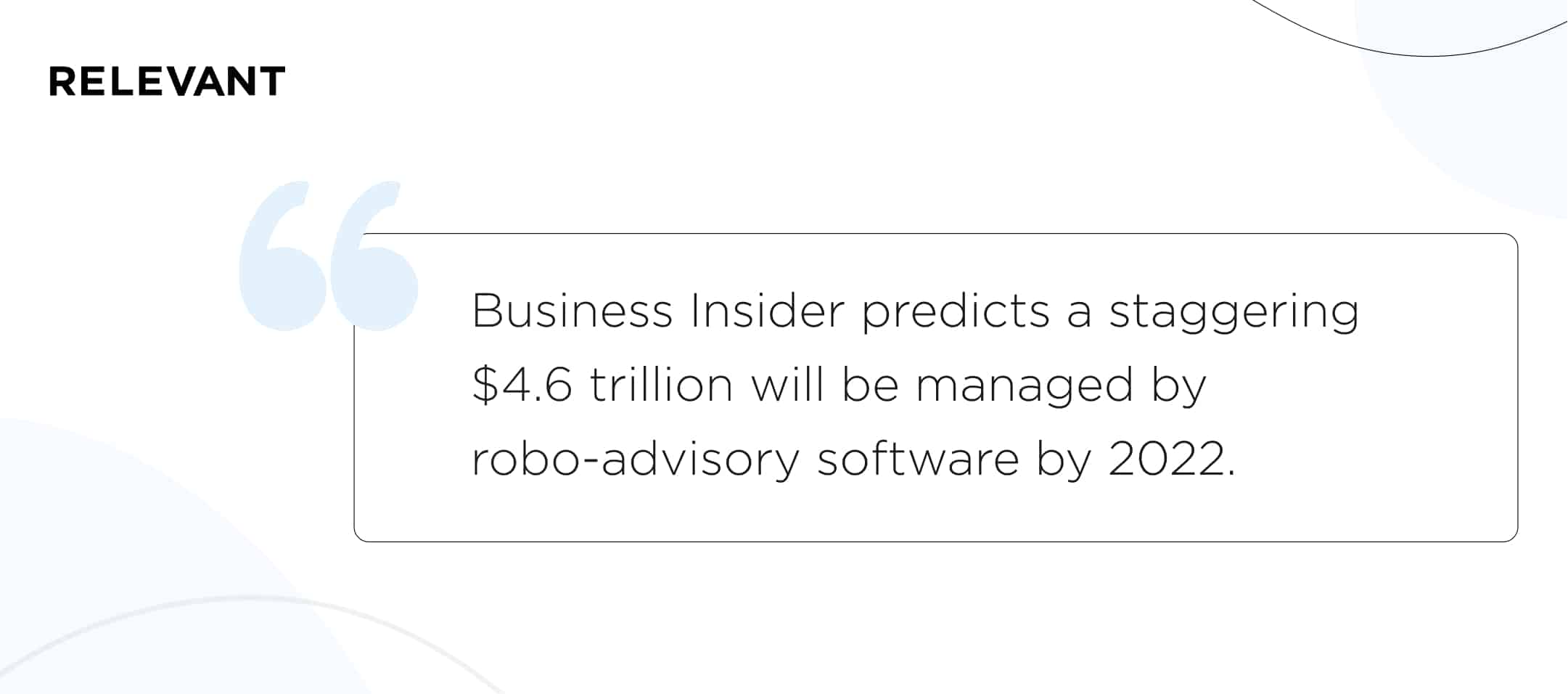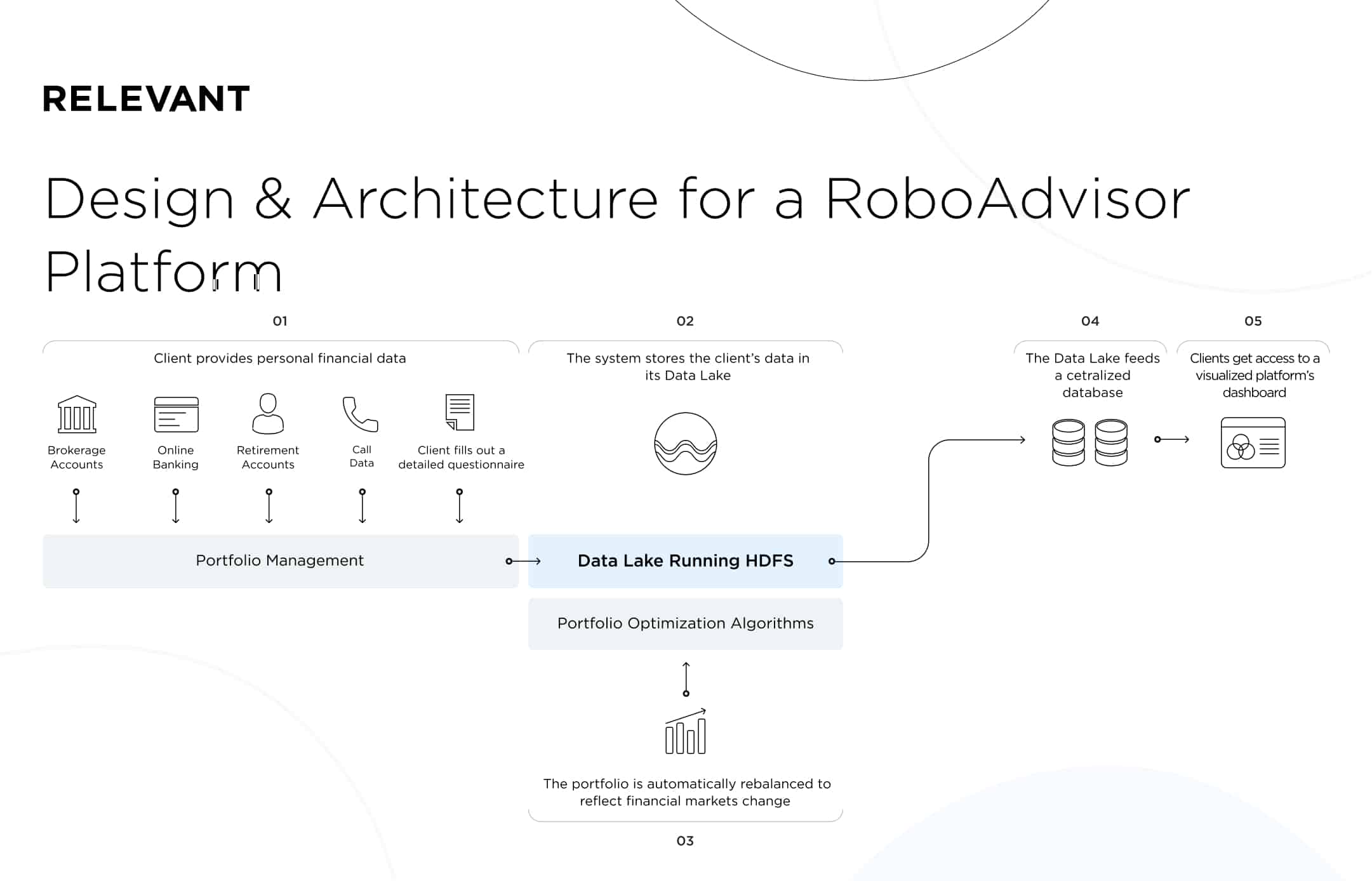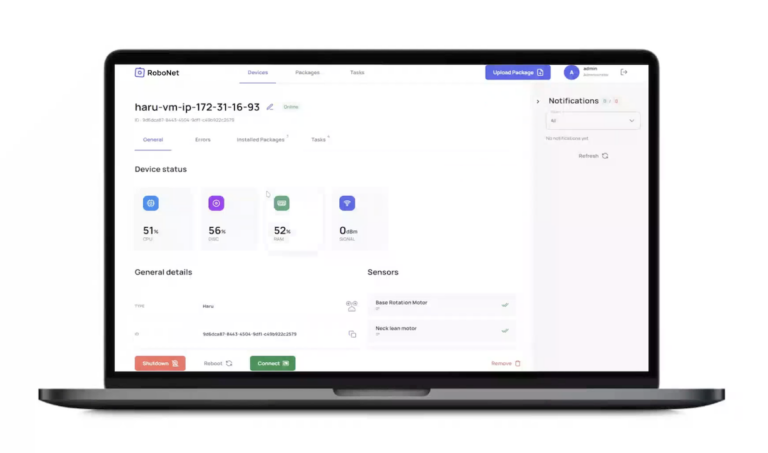Robo-Advisory Software Development in Simple Terms
Updated: August 27, 2021
The time has come. Software equipped with Artificial Intelligence (AI) is giving out investment advice, and we’re getting used to it.
It’s not a psychic reading—the algorithmic engine of a modern Robo-Advisor (RA) takes multiple factors into account before telling the client where to put their hard-earned cash. Their income, marital status, financial goals, and risks are all calculated before an automated investment is placed on their behalf, thanks to robo-advisory software development.
200+ companies from 25 countries outsourced software development to Relevant
We provide companies with senior tech talent and product development expertise to build world-class software. Let's talk about how we can help you.
Contact usThe popularity of RA services is on the rise, and Business Insider predicts a staggering $4.6 trillion will be managed by these systems by 2022. Many banks and wealth management companies see robo-advisory apps as an opportunity to broaden their reach and tap into new customer segments.

Developing sophisticated tools like this takes a lot of expertise and creativity. Luckily, Relevant has both, topped with solid hands-on experience in fintech software. Take a minute and check out two of our projects:
- FirstHomeCoach, a Software-as-a-Service platform that assists UK homebuyers in finding their perfect property, getting a mortgage, insurance, and completing all the legal paperwork.
- Payroll, an application that drastically outperforms conventional accounting software at calculating payroll. It’s flexible and can be adapted to different workflows with minimum effort.
We know a lot about robo-advisory software development, and that’s why we’d like to tell you:
- How robo-advisors work
- The requirements of an RA platform from the business standpoint
- The typical components of an RA platform and the tech behind them
Let’s begin!
Table of Contents
How does a robo-advisor work?
Recently, a new subdomain of fintech has emerged. Its name is wealthtech and it employs cutting-edge technology to automate and streamline investment for everyone. Wealthtech includes robo-advisors, micro-investment, robo-retirement, and digital brokerage. RA tools, just like their human counterparts, rely on data analysis and knowledge of the market. But where humans tend to play it by ear, an algorithm carefully calculates every move.
Robo-advisory services are powered by AI and Machine Learning—the kind of tech we are very familiar with at Relevant.
In short, a robo-adviser is an online tool that offers automated wealth management with minimal capital requirements. Clients simply fill out a form that feeds the AI-enabled engine enough data to determine the best investment options for their specific financial background and objectives.
Once the initial setup and verification are complete, the software forms an investment portfolio using sophisticated algorithms. The software even makes the actual investments—in stock, bonds, real estate, currencies, precious metals, or other commodities.
RA platforms provide their services for a small subscription price or by charging a trading fee. Many solutions, like Betterment—the current industry leader—offer a mix of automated and human-assisted models. This service comes with an additional surcharge of 0.40% per year on the balance for premium investment advice.
Want to know more about the intricacies of robo-advisory platforms? Or what it takes to build an ai robo-advisor? Then keep on reading.
Business requirements for a robo-advisory platform
RA platforms offer many advantages over the more traditional manual investment options. First, it’s the improvement in speed and accuracy of analysis and the unbiased judgment that humans simply cannot deliver. Then there’s the low starting balance threshold that democratizes the market. And let’s not forget the service is also available 24/7.
But how does all of this translate into identifying business requirements for robo-advisor platform development?
Here is our list of features every RA platform should have:
- Client data collection and analysis. This is where it all starts—with gathering all the relevant data to assess the client’s financial background, investment history, and risk factors. A straightforward and intuitive interface for collecting this information effectively is a must.
- A client segmentation strategy. Investment choices will depend heavily on this phase. As RA platforms often serve customers with a lower balance minimum than human wealth advisors, a different segmentation logic must be applied.
- Portfolio management. Depending on the client’s risk profile and settings, RA tools can balance funds between risky and risk-free assets. Portfolio rebalancing is another savvy feature that helps react to the changes in economic conditions in real-time.
- Algorithms for portfolio allocation. The software has built-in algorithms that determine the most efficient investment opportunities while balancing risk appropriately.
- Tax-loss harvesting. A practice commonly used to offset tax liabilities from profits on one security by selling a similar one at a loss. Automating this process makes perfect sense and is standard for RA platforms.
- Convenient access to the client’s financial history. Nothing gives you a better idea of the current state of affairs than an all-in-one view of all the stats and preferences.
Are you hanging in there? We never said robo-advisor platform development was an easy task, but we do think the end result is worth the effort. Let’s take a look at the standard components of an RA platform – that is, all the little cogs that keep the machine working.
200+ companies from 25 countries outsourced software development to Relevant
We provide companies with senior tech talent and product development expertise to build world-class software. Let's talk about how we can help you.
Contact usComponents of a robo-advisory platform
Below is a list of features and processes the system requires to operate. Note that while most of the core features mentioned here were created for the client, some of the functionality is intended for managing investors.
- Investor dashboard. A consolidated view for portfolio performance analysis, investment management, and all communication and reporting.
- Algorithmic engine. A set of algorithms created by finance specialists and translated into code by software developers, designed to calibrate the client’s portfolio according to their goals and risks.
- Investor onboarding with balance projection. Registration and Know Your Customer verification tools, investor risk profiling, and a visual representation of a forecast balance for greater engagement.
- Asset allocation and portfolio rebalancing. Automated management of assets according to the set risk and allocation goals.
- Behavioral analysis backed by AI. Tools for analyzing and predicting the client’s behavior, based on transaction data and interpreted by AI-powered algorithms.
- Portfolio construction and optimization. Essential management tools like model portfolio creation and portfolio management according to the Modern Portfolio Theory.
- Portfolio health analysis. A set of instruments for analyzing various metrics and making changes to the client’s portfolio. The data gathered in the process can be used later to fine-tune portfolio offers.
- Questionnaire builder. A feature particularly useful when building risk profiles. Supervising wealth managers can create questions of varying complexity which can be useful for the onboarding stage.
So, what’s the tech that makes all of this work?
Technology requirements for an RA platform
We’ll do our best to keep this brief and try not to intimidate you with too many technical details. While you won’t be able to build an RA platform after reading this part, you’ll have a much better understanding of the way they work.
- First, the client provides personal financial data by filling out an online form and linking their banking and/or retirement accounts to the system through an appropriate API (Application Programming Interface).
- The system then stores the client’s data in its Data Lake using secure distributed storage. HDFS (Hadoop Distributed File System) is the standard of choice in this instance, as it allows data to be received and processed from various systems with different formats and infrastructures.
- The software uses specific algorithms to form, manage, and optimize the client’s portfolio. As the conditions of financial markets change, the portfolio is automatically rebalanced to reflect this. When necessary, the system performs tax-loss harvesting operations to minimize tax liabilities.
- Upon processing the transactional data, the software feeds it to the Enterprise Data Warehouse (EDW), a centralized database available for analytics and broader use.
- The client’s investment history, portfolio progress, risks, and other relevant information can be visualized with the platform’s dashboard.

As you can see, robo-advisory platforms are sophisticated pieces of software that leverage the potential of modern technology. One more thing to keep in mind is you must adhere to the fintech security requirements when dealing with sensitive user data in finance-related apps.
Are you still with us? We’re almost there. But our article would be incomplete without this last part. How can you get started with your online financial advisor software development?
Robo-advisor development
If you’re still on the fence about building your own robo-advisory service, our advice is: it’s time to get off the fence and take the first step. You need to find a reputable software partner who is comfortable with financial app development and start creating your RA platform today.
It might seem overwhelming, but we think you should get started by having a chat at Relevant. With our extensive experience in providing fintech software development services, we can begin working on your new shiny robo-advisor in no time!
Our core services:
Do you want a price estimate for your project?
Do you know that we helped 200+ companies build web/mobile apps and scale dev teams?
Let's talk about your engineering needs.
Write to us












